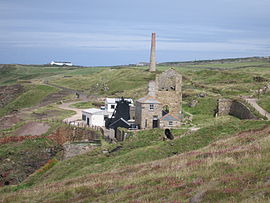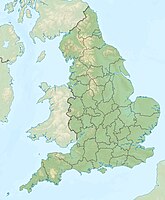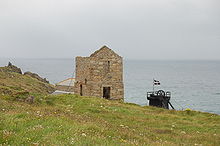Levant mine
| Levant mine | |||
|---|---|---|---|
| General information about the mine | |||
| Steam boiler house with a small chimney, winch building and pump building as well as the cooling pond on the left | |||
| Mining technology | Underground mining | ||
| Information about the mining company | |||
| Operating company | Mining Company Levant | ||
| Employees | 500 | ||
| Start of operation | 1820 | ||
| End of operation | 1963 | ||
| Successor use | museum | ||
| Funded raw materials | |||
| Degradation of | Copper, tin | ||
| Greatest depth | 600 m | ||
| Geographical location | |||
| Coordinates | 50 ° 9 '8 " N , 5 ° 41' 8" W | ||
|
|||
| county | Cornwall | ||
| Country | United Kingdom | ||
| District | Mining district of St Just | ||
The Levant Mine is a disused mine in the St Just Mining District with an attached museum where a working Balancing - steam engine can be visited. The mine is located at Trewellard , north of St Just in Cornwall , England , just off the coast about 10 kilometers northeast of Land's End .
history
In the early 19th century, Cornwall was the world's most important supplier of copper. Among the mines in Cornwall at that time, the Levant Mine took a top position. From 1820 onwards, the mine began to produce copper and later also tin . In the productive years, up to 500 people were employed here. In 1857 steam-powered driving was installed to allow the miners to be transported in and out of the mine more quickly . The cumbersome and slow climb over journeys was no longer necessary. In 1873 five steam engines were in operation. These were used for ventilation and drainage of the mine and for mechanical processing of the ore.
The mine extended to a depth of about 600 meters and reached about 2.5 kilometers from the cliffs below the sea floor. Because of its special location, it is nicknamed mine under the sea . When the reserves were exhausted, the mine was abandoned in 1930 and the mine overflowed.
In 1959, a search for new ore deposits was carried out in the Geevor mine, which was about 400 meters northeast and was still in operation at the time . Since raw material deposits were assumed to be in the west, the Levant mine was used again and a new attempt at mining was started. The water in the mine was pumped out . It was found that seawater penetrated the mine at a point where the miners had previously dug very close to the sea floor. In 1962 and 1963 the site was searched for with the help of divers and the pit was sealed with concrete. At the same time a tunnel was dug from the Geevor Mine to the Levant Mine. The ore yield was disappointingly low, however, and so it was decided to close the operation of the Levant Mine again and to develop other known veins under the sea from Geevor.
Ore treatment

In addition to the miners underground, numerous men, women and children were also employed at the mine, who during the processing work for days to pick (separate) the coveted raw materials copper and tin from the rock. The material from the pit was then crushed to a sandy powder using a steam-powered stamping mill and then heated in a rotary kiln ( calcination ). After cooling down, the individual components could be separated from one another by a few chemical reactions. During the calcination, arsenic is also released from the rock. In the northern part of the complex, the remains of four of these ovens are still preserved. A long underground flue led the gases to the chimney that is still preserved today. The arsenic could be separated in compression chambers in the gas exhaust and collected for sale. The processing of the copper-bearing ore was carried out first on site, later after a ship transport in Wales . Nothing in the area has been preserved from the copper separation. A total of 129,268 tons of copper (1820-1927) and 27,907 tons of tin (1835-1929) and small amounts of arsenic, silver and gold were mined.
accident
On October 20, 1919, there was an accident in the mine in which 31 miners lost their lives and many were buried. At the time of the accident, over 100 miners were on the art of driving when a mounting bracket on the balancer , the central lever, broke. The heavy log that held the structure fell into the shaft, tearing the stairs of the driving skill with it. As a result, the driving skills were not repaired and the lowest tunnels of the mine were abandoned. In the 1962 book, The Mine Under the Sea by Jack Penhale the story is taken of the accident. The book describes the life of miners and their families in the Levant Mine in Cornwall in 1920.
exhibition
The entire area has a length of about 700 meters and a width of about 300 meters. There are still some chimneys, buildings and remains of buildings that can be viewed. Open shafts are secured by grids, but allow glimpses into lower floors. After the mine closed in 1930, some of the facilities were saved from scrapping with the help of the National Trust and enthusiasts. Since 1967 the area has been completely under the protection of the National Trust. The ruins and foundations still show the extent of the complex today. The foundations and colorful floor tiles of the once impressive administration building of the mine have been preserved. Some of the buildings could be restored and now contain the visitor center. Part of the exhibition is a functional, over 100 year old balancing steam engine. The former conveyor reel was saved in 1935 and, after 60 years of downtime, it was reconditioned by a group of volunteers. In contrast to earlier times, when the machine was fired with wood and coal, today gas is used to heat the steam boiler . A short tour of the preserved dry parts of the mine is also possible. The Geevor Mine, which was abandoned in 1990, also has a visitor center operated by the National Heritage Memorial Fund .
Web links
- Information about the Levant Mine and the Steam Engine from the National Trust
- Collection of images and documents
- Collection of images
- Description and pictures of the Levant Mine
Individual evidence
- ↑ http://www.geevor.com/index.php?object=176
- ↑ http://www.cornwall-calling.co.uk/mines/st-just-area/levant.htm
- ↑ C. Noall: Levant. The Mine Beneath The Sea. D. Bradford Barton Ltd, Truro, Cornwall, 1970.
- ↑ J. Penhale: The Mine Under The Sea. JH Lake & Co. Ltd, Falmouth, Cornwall, 1962.
- ↑ http://www.cornwall-calling.co.uk/mines/st-just-area/levant.htm



